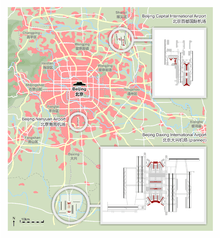Beijing Daxing International Airport

Beijing Daxing International Airport (Chinese: 北京大兴国际机场) is a planned new international airport serving Beijing.[1] The name of the future airport has not been made official yet.[2]
The airport is to be built in Daxing District, located 46 km (29 mi) south of city center.[3] The airport will be located on the southern part of Daxing along the border with Hebei province.[4] The new airport is expected to serve Beijing, Tianjin and Hebei.[5] The airport will cover an area of 2,680 hectares (6,600 acres).[2]
The projected completion date for the new airport is September 2019.[6] A new rapid transit line is planned that will connect the airport to Beijing South Railway Station with a journey time of 30 minutes.[4] All flights from Beijing Nanyuan Airport, which is currently only used by China United Airlines, will be transferred to Daxing.[7]
The airport's master plan has been designed by airport consulting firm NACO and will feature a ground transportation centre providing the airport with public transportation links to high-speed rail, metro, expressways, Beijing Airport Bus routes, local buses and inter-airport transportation system. Other consulting firms are competing to design the terminal building.[8]
Development history
A second airport for Beijing was proposed in 2008.[4] By 2012, the existing Beijing Capital International Airport was running at near its full design capacity.[9][10]
Initial proposals
Early media reports during September 2011 suggested that there could be up to 9 runways: 8 runways for civil aviation plus one runway dedicated to military usage.[3][5][7][11][12] It would replace Beijing Capital International Airport (which had 83 million passengers in 2013, second most in the world) as the main airport of Beijing and the largest in China and was being planned as a domestic-only airport. The airport was planned to be able to handle 120 to 200 million passengers a year, which, if capacity were fully used, would make it the world's busiest airport by passenger traffic, surpassing Hartsfield–Jackson Atlanta International Airport.[13]
It is not yet decided how flights will be divided between the two Beijing Airports. One suggestion was planning to have one airport focus on international flights and the other to focus on domestic flights.[14] The airport is scheduled to relocate both SkyTeam and Oneworld airlines to the new airport with Star Alliance airlines and other airlines remaining at Capital, effectively making both airports international hubs.[15] However, on 30 July 2016, it was announced that China Southern Airlines, China Eastern Airlines and Xiamen Airlines along with other SkyTeam airlines will move to the new airport with Air China, other Star Alliance carriers, and presumably Oneworld carriers remaining at Capital.[16]
Approval for construction
Official approval for construction by the Chinese State Council and officials was given on Sunday, 13 January 2013. It called for an airport to be constructed in the southern part of Daxing, along the Hebei border. No design or plans were released due to ongoing negotiations. It was stated that it would consist of 7 runways, 6 for civilian use and 1 for military purposes. Construction is expected to be completed in September 2019[6] with a capacity of handling 75 million passengers by 2025. The estimated cost of construction is at least 70 billion RMB (US$11.2 billion). The 37 km (23 mi) rail link to Beijing South Railway Station has also been included.[4][17]
Construction
Construction of the airport began on December 26, 2014.[18]
References
- ↑ "CRI: Beijing Builds World's Biggest Airport due to Necessity". CRI. Retrieved 2013-03-02.
- 1 2 "New Beijing airport touted as world's busiest: media". In.reuters.com. 2012-02-26. Retrieved 2013-03-02.
- 1 2 Jonathan Watts in Beijing (2011-09-08). "Beijing set to become world's busiest aviation hub with new mega-airport". London: The Guardian. Retrieved 2013-03-02.
- 1 2 3 4 "China Daily USA - New capital airport cleared for takeoff". Usa.chinadaily.com.cn. Retrieved 2013-03-02.
- 1 2 Joanna Corrigan (2011-09-14). "Mail Online: China plans third airport for Beijing which will outstrip Heathrow as the world's busiest". London: Dailymail.co.uk. Retrieved 2013-03-02.
- 1 2 "首都新机场跑道呈三纵一横分布 规划7条跑道". news.carnoc.com. Retrieved 2016-01-12.
- 1 2 "Gigantic airport to be built in China". Wanderlust. 2011-09-15. Retrieved 2013-03-02.
- ↑ Alex Davies (2012-10-09). "Beijing Is Building An Airport That's Bigger Than JFK, LaGuardia, And Newark Combined". Businessinsider.com. Retrieved 2013-03-02.
- ↑ "CNN Travel - Beijing approves US$11.2 billion international airport". Travel.cnn.com. 2013-01-16. Retrieved 2013-03-02.
- ↑ "Beijing Capital Airport to Reach Its Design Capacity of 80 Million Passengers Within This Year". WCarn.com. 2012-05-24. Archived from the original on 2014-05-12. Retrieved 2013-03-02.
- ↑ Economic Times: China plans to build world's biggest airport near Beijing Archived May 27, 2012, at the Wayback Machine.
- ↑ "Beijing's 2nd airport to be ready by 2017". China Daily. 2011-06-22. Retrieved 2013-03-02.
- ↑ "Beijing plans to build world's largest airport". Indian Express. 2012-02-26. Retrieved 2013-03-02.
- ↑ "China Daily USA - Beijing's new airport expects inaugural flight in 2017". Usa.chinadaily.com.cn. 2011-06-21. Retrieved 2013-03-02.
- ↑ "Bejing's Second Airport Allocated To SkyTeam Carriers". Aviation Week. 2012-09-21. Retrieved 2013-03-02.
- ↑ http://english.cri.cn/12394/2016/07/30/3521s936025.htm
- ↑ "Chinese government approves construction of second Beijing airport". FlightGlobal. 2013-01-14. Retrieved 2013-03-02.
- ↑ "Construction begins on 2nd international airport in Beijing". Asahi Shimbun. 2014-12-26. Archived from the original on 2015-12-30. Retrieved 2014-12-30.
Coordinates: 39°31′N 116°23′E / 39.517°N 116.383°E